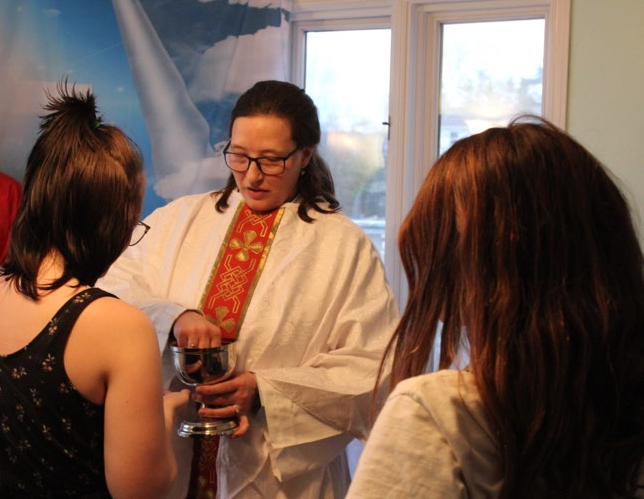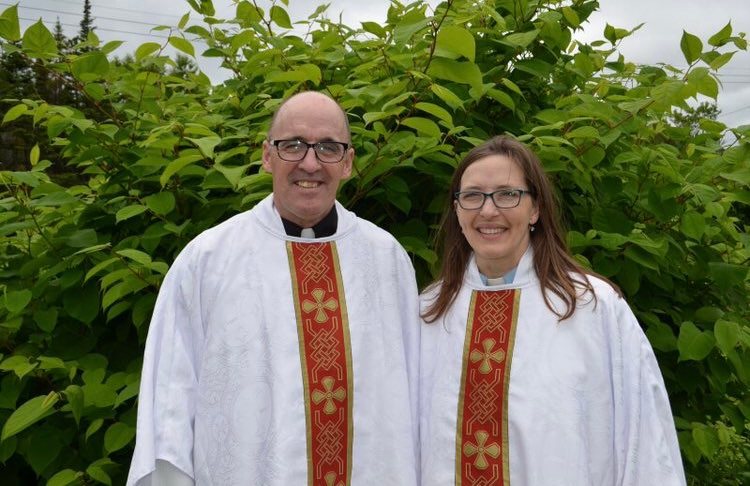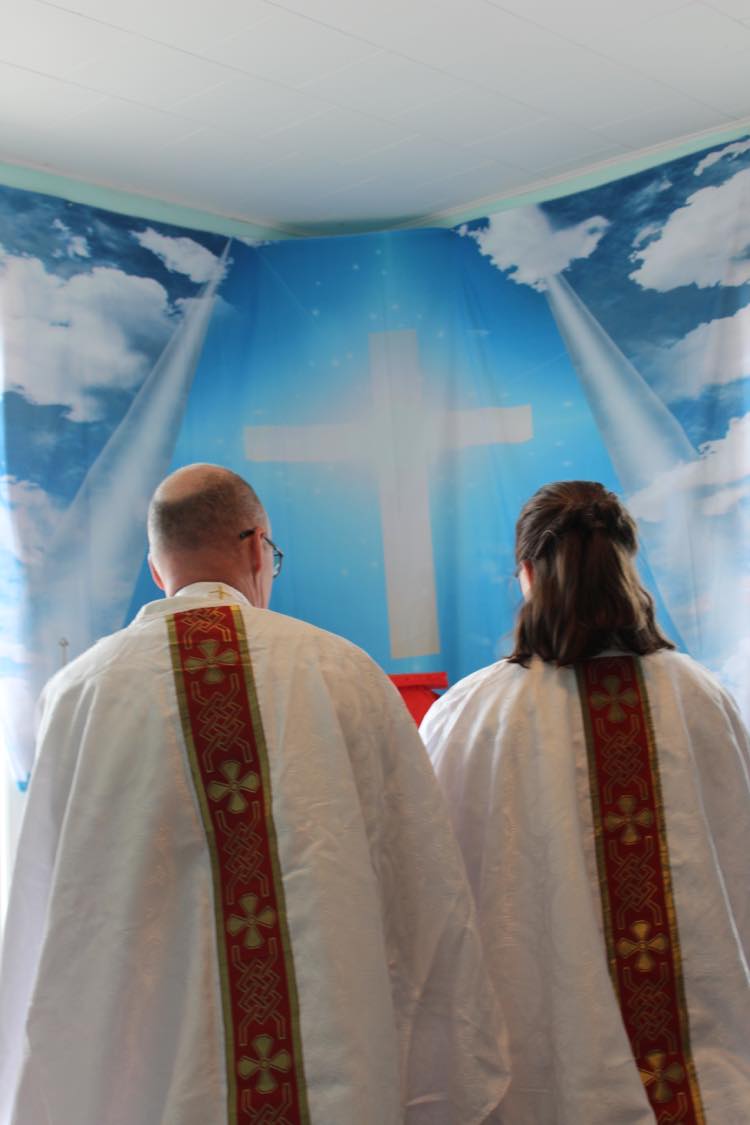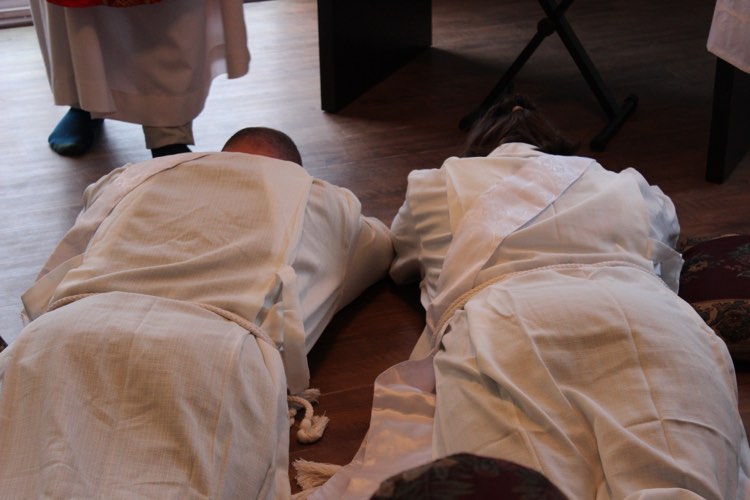- Home
- about stbrigits
- Women Clergy
Simply Catholic and Welcoming You
Women Clergy in The Catholic Church

Amma Charlene distributing the Holy Eucharist. She is a Monseigneur in St. Brigit's Community Catholic Church
Women clergy are officially excluded from many of the Catholic Churches, specifically as ordained clergy (bishops, priests, and deacons), yet evidence exists that women held leadership roles in the early church, and some women's ordination movements continue today.
Were there ever female priests in the Catholic Church?
The historical evidence points to women serving in ordained roles from its earliest days in both the Western Church as well as the Eastern Church.
Here's a more detailed look at women's roles in the Catholic Church throughout history:
Early Church:
Women held important leadership positions:
In the early Christian communities, women clergy served as deacons, presbyters (also known as elders), and played a role in ministry alongside their male counterparts.
Examples in scripture:
Paul's letter to the Romans mentions Phoebe, a deacon of the church in Cenchreae.
Deaconesses:
In the early centuries of Christianity, women were ordained into several ministries, including that of a deaconess.
Change in definition of ordination:
A shift in the definition of ordination in the 11th and 12th centuries removed women clergy from the ordained ministry and attempted to erase records of women's ordination in the past.
Medieval and Modern Church:
Suppression of women's ministry:
Over time, the larger Church Rites marginalized and then suppressed women clergy's public ministry in both the East and West.

Husband and wife team, Fr Philip and Amma Charlene Bradley, BOTH hold the position of Monseigneur in St. Brigit's Community Catholic Church
Catholic Church Stance on Women Clergy Today
Catholic Church Hierarchy Excludes Women:
Today, the mainstream Catholic Church continues its centuries-long tradition of excluding women clergy from the hierarchy of ordained clergy, which includes priests, bishops and deacons.
Roman Catholic Womenpriests Movement:
In the 2000's, some individuals, including the "Danube Seven", claimed to have been ordained by a male bishop, and they formed the Roman Catholic Womenpriests movement.
Vatican's stance:
The Vatican's stance has denied the validity of any women clergy ordinations, and the women who received ordination were excommunicated.
Ongoing Debate:
The issue of ordination of women clergy continues to be a source of debate and advocacy within the Catholic Church.
Notable Women in Catholic History:
Despite the lack of ordination, numerous influential Catholic women have played significant roles throughout history as theologians, abbesses, monarchs, missionaries, mystics, martyrs, scientists, nurses, religious sisters, doctors of the church, and canonized saints.
New research recently unveiled in Rome suggests women had a greater role in the early church's ministries and liturgies than previously thought and women clergy were present at church altars as deacons, priests and even bishops.
In the late second century AD, the Montanist movement ordained women priests and bishops. In 494 AD, in response to reports that women were serving at the altar in the south of Italy, Pope Gelasius I wrote a letter condemning female participation in the celebration of the Eucharist.
Saint Brigit, lived from the late 400s/early 500s C.E. in Ireland, and there are at least two different hagiographies pertaining to her. Both are written from a Christian perspective, as seen in the style and approach, and were written within a few hundred years of her life. In Roman Catholic belief, these texts, due to their hagiographical form, authorship, and prominence in scholarship, hold as true. The first text is Vita Sanctae Brigitae II or the Life of Saint Brigit Part Two, likely written by Cogitosus, a monk at Kildare.
The Second work; Bethu Brigte, is the central text discussing Saint Brigit’s life and has the most scholarship written about it. Upon her planned ordination to become a nun, the text declares that, “The Bishop being intoxicated with the grace of God there did not recognize what he was reciting from his book, for he consecrated Brigit with the orders of a BISHOP” (Bethu Brigte 24). Not only is she ordained, the “accidental” ordination was because the bishop was filled with God’s grace. If this is not a clear indication of the spiritual correctness of the ordination of women and the appropriateness of women clergy, then what is?
There is much evidence in these works to support, indeed, declare that St. Brigit did hold the office of Bishop and discharged her duties with excellence.
Still the church's official stance, consistent with the removal of almost any evidence of women's actual roles in the early church, is that St. Brigit was an Abbottess and would have held similar authority to a Bishop but only within the convents. Yet the writings indicate that she was often called to meetings with the other bishops.
1 Timothy 2:12 is the twelfth verse of the second chapter of the First Epistle to Timothy.
But I suffer not a woman to teach, nor to usurp authority over the man, but to be in silence.
This is the most common Justification offered for keeping women out of the clergy in the Catholic, and other Christian Churches.
The verse has been criticized for its sexism and its perceived inconsistency with other verses attributed to Paul, such as Galatians 3:28, which states "there is neither male nor female, for ye are all one in Christ Jesus." Further there are many examples of female teachers and leaders known to Paul, such as Priscilla and Phoebe, to support their conclusion that the verse has been mistranslated. Most modern scholars believe 1 Timothy was not actually written by Paul.
Women were the last disciples at the cross and the first at the empty tomb. Women in general and women clergy specifically remained integral to the work of the church in its early centuries.
The early church considered Mary Magdalene an “apostle to the apostles.” Yet the church has for centuries cast shadow on or outright impugned her reputation. Luke also relied heavily on the testimony of women as he wrote both Luke and Acts.
In the Bible, Mary Magdalene was a follower of Jesus who, after being cleansed of seven demons, financially supported his ministry, witnessed his crucifixion and burial, and was the first person to see him after his resurrection, tasked with sharing the news of his resurrection.
According to all four Gospels, Mary Magdalene was among the first to witness the empty tomb and, either alone or as part of a group, was the first to witness Jesus's resurrection.
After seeing Jesus resurrected, He instructed her to share the news that he was alive, a role that led to her being called the "Apostle to the Apostles".
Mary Magdalene is considered a saint by various denominations, including Catholic, Eastern Orthodox, Anglican, and Lutheran. Some Protestant churches honor her as a heroine of the faith.
There have been debates and misconceptions about Mary Magdalene, including claims that she was a prostitute or Jesus's wife, which are not supported by the Bible.
A number of women served as leaders of the house churches that sprang up in the cities of the Roman Empire—the list includes Priscilla, Chloe, Lydia, Apphia, Nympha, the mother of John Mark, and possibly the “elect lady” of John’s second epistle.
In the 2nd century, Clement of Alexandria wrote that the apostles were accompanied on their missionary journeys by women who were not marriage partners, but colleagues, “that they might be their fellow ministers in dealing with housewives (thus women clergy). It was through them that the Lord’s teaching penetrated also the women’s quarters without any scandal being being aroused. We also know the directions about women deacons which are given by the noble Paul in his letter to Timothy."
Junia was mentioned by Paul in Romans 16 as “of note among the apostles.” Until the Middle Ages, the identity of Junia as a female apostle and thus surely an example of women clergy, was unquestioned.
Paul also mentions Phoebe in Romans 16, “a deacon of the church at Cenchreae.”
The four daughters of Philip appear in Acts 21:9 as prophetesses. Eusebius viewed these daughters as “belonging to the first stage of apostolic succession.” Another prophetess attested to by extra-biblical tradition is Ammia, who prophesied in Philadelphia during New Testament times, and was received with reverence throughout Asia Minor. The first preserved mention of her dates to about 160 A.D.
Women who ministered with Jesus
Luke's gospel is unique in documenting that there were many women who benefited personally from Jesus's ministry, but who also ministered to him and with him—even to the point of accompanying him and the Twelve on evangelistic journeys. Most prominent among these is, again, Mary Magdalene.
Can Women Preach in a Catholic Church?
Catholics who have sat through enough bad homilies can find it difficult to understand why the church does not allow women to preach about the good news at Mass. To be clear, the Catholic Church does allow women and non-ordained men to preach at the discretion of the local bishop.
Catholic Women Clergy today
Despite the mainstream ban on women clergy and in western rite mainstream churches the ban on married clergy, both women clergy and married clergy do exist today. In churches such as the Anglican Church (yes they are Catholic too, as are the Lutherans), The Liberal Old Catholic Church, The Holy Celtic Catholic Church, various Independent and Community Catholic Churches, Including our own St. Brigit's Community Catholic Church and a growing number of others, women clergy and married clergy thrive in ever growing numbers.
These are clergy with full Apostolic Succession and Valid Priesthood Orders. Their priesthood and Apostolic Succession lineages often combine both western and eastern rites.
Recent Articles
-
Catholic-Confession
Apr 19, 25 08:53 PM
Full breakdown of the Catholic Confession Sacrament of Reconciliation -
Ordination, incardination and dismissal of clergy
Mar 03, 25 06:47 PM
Overview of Ordination to Holy Orders, incardination and dismissal of clergy -
Catholic Last Rites
Mar 03, 25 06:41 PM
An explanation of the Catholic Last Rites and Anointing of the Sick
Boat Harbour West, Newfoundland, Canada. Cell Number 709-276-0626


